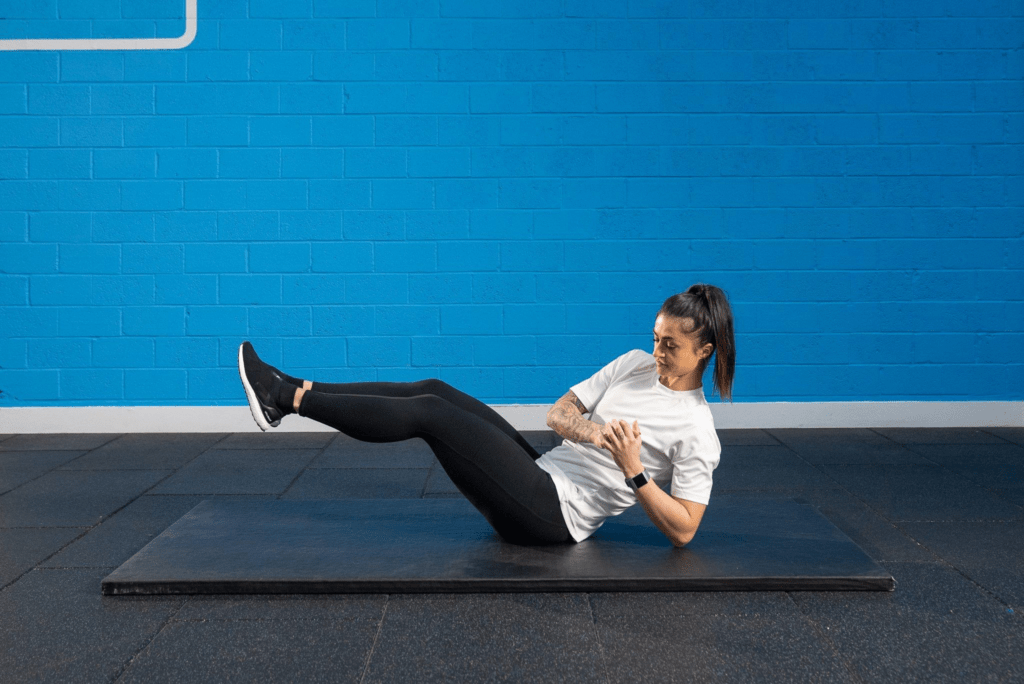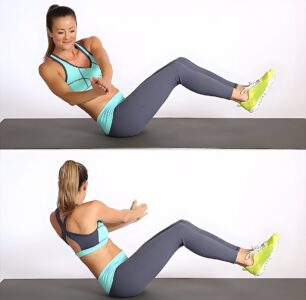Rugby demands strength, agility, and resilience from its players. Whether you’re a seasoned player or just starting out, having a strong core is essential for success on the field. One exercise that can greatly benefit rugby athletes is the Russian Twist. In this article, we’ll explore what the Russian Twist is, how it targets specific muscles, its benefits for rugby players, proper technique, variations, integration into your training routine, safety tips, common mistakes to avoid, and complementary exercises.
What Muscles Do Russian Twists Target
The Russian Twist is a dynamic core exercise that engages multiple muscle groups, primarily focusing on the muscles of the core. Let’s delve deeper into the specific muscles targeted by this exercise:
1. Obliques
The obliques are a group of muscles located on the sides of the abdomen, running diagonally from the lower ribs to the pelvis. They consist of two main parts: the external obliques and the internal obliques.
- External Obliques: These muscles are responsible for trunk flexion, lateral flexion, and rotation of the torso. During the Russian Twist, the external obliques contract to rotate the torso from side to side.
- Internal Obliques: Situated beneath the external obliques, the internal obliques assist in trunk rotation and lateral flexion. They work synergistically with the external obliques to execute the twisting motion of the Russian Twist.
2. Rectus Abdominis
The rectus abdominis, commonly known as the “six-pack” muscles, is a long, flat muscle that extends vertically along the front of the abdomen. It plays a key role in spinal flexion and stabilization of the pelvis.
- Spinal Flexion: The rectus abdominis contracts during the Russian Twist to assist in flexing the spine forward as the torso rotates from side to side.
3. Transverse Abdominis
The transverse abdominis is the deepest layer of the abdominal muscles, wrapping around the abdomen like a corset. It provides stability and support to the spine and pelvis, acting as a natural weight belt.
- Core Stability: During the Russian Twist, the transverse abdominis engages to stabilize the core and maintain proper alignment of the spine, preventing excessive rotation and protecting against injury.
4. Hip Flexors
While the primary focus of the Russian Twist is on the core muscles, the hip flexors also play a secondary role in stabilizing the pelvis and assisting in the rotational movement of the torso.
- Pelvic Stabilization: The hip flexors, including muscles such as the iliopsoas and rectus femoris, help stabilize the pelvis and maintain proper alignment during the twisting motion of the Russian Twist.
By targeting these key muscle groups, the Russian Twist effectively strengthens the core, improves rotational power, and enhances overall athleticism, making it a valuable exercise for rugby players seeking to excel on the field.
What Are the Outcomes
Performing the Russian Twist consistently can lead to several outcomes beneficial for rugby players. These include improved core strength, enhanced rotational power, increased agility, and better balance. Additionally, a strong core can help reduce the risk of injury during tackles, scrums, and other dynamic movements on the field.

How Do They Benefit Rugby Players
The benefits of the Russian Twist extend beyond simply strengthening the core muscles; they directly contribute to the specific demands and challenges faced by rugby players. Let’s explore how incorporating the Russian Twist into training routines can positively impact rugby performance:
1. Enhanced Rotational Power
Rugby involves a significant amount of rotational movements, such as passing, tackling, and evading opponents. Developing rotational power through exercises like the Russian Twist allows players to generate force efficiently while twisting and turning on the field. This translates to more powerful passes, stronger tackles, and quicker changes in direction, giving players a competitive edge over their opponents.
2. Improved Core Stability
A strong and stable core is essential for maintaining proper body alignment and absorbing impact during contact situations in rugby. The Russian Twist targets the deep core muscles, including the transverse abdominis and obliques, which play a crucial role in stabilizing the spine and pelvis. By strengthening these muscles, rugby players can enhance their ability to withstand physical collisions, maintain balance, and reduce the risk of injury during tackles, scrums, and rucks.
3. Increased Agility and Balance
Rugby requires agility, coordination, and balance to navigate the dynamic and unpredictable nature of the game. The Russian Twist challenges these aspects of athleticism by requiring players to rotate their torso while maintaining control and stability. By improving agility and balance through exercises like the Russian Twist, players can maneuver more effectively on the field, evade defenders, and execute intricate footwork with precision.
4. Transferable Strength
The functional nature of the Russian Twist makes it a highly transferable exercise for rugby players. The rotational movement pattern closely mimics actions performed during gameplay, allowing athletes to directly apply the strength and power gained from this exercise to their performance on the field. Whether it’s delivering a powerful pass, driving through a tackle, or executing a sidestep, the strength developed through Russian Twists translates seamlessly into rugby-specific movements.
5. Injury Prevention
Injuries are a common concern in rugby due to the physicality and high-impact nature of the sport. By strengthening the core muscles, particularly the stabilizing muscles of the spine and pelvis, the Russian Twist can help reduce the risk of common rugby injuries, such as lower back strains, core muscle strains, and pelvic instability. Additionally, improved core strength and stability can enhance overall body mechanics, reducing the likelihood of compensatory movements that may lead to injury over time.
How to Perform the Exercise Correctly
- Starting Position: Sit on the floor with your knees bent and feet flat on the ground. Lean back slightly, maintaining a straight back and engaging your core muscles.
- Hand Position: Clasp your hands together in front of your chest or hold a weight plate for added resistance.
- Execution: Keeping your core engaged, slowly rotate your torso to one side, bringing your clasped hands or weight towards the floor beside your hip.
- Return to Center: Exhale as you return to the center position, then repeat the movement on the opposite side.
- Repetitions: Aim for 10-15 repetitions per side, gradually increasing as you build strength and endurance.
Variations of the Exercise
- Weighted Russian Twist: Hold a dumbbell, medicine ball, or weight plate to increase resistance and challenge your core muscles further.
- Feet Elevated Russian Twist: Elevate your feet off the ground to increase the difficulty and engage the lower abdominal muscles.
- Banded Russian Twist: Secure a resistance band around a stable object and loop it around your hands for added resistance throughout the movement.
Integrating The Exercise into Your Routine
Incorporating the Russian Twist into your training routine can be done in several ways:
- Core Workout: Include Russian Twists as part of a comprehensive core workout, performing multiple sets and repetitions to target different areas of the core.
- Circuit Training: Incorporate Russian Twists into a circuit training routine, alternating between core exercises, strength training, and cardio to maximize efficiency and effectiveness.
- Prehabilitation: Use Russian Twists as part of a prehabilitation routine to prevent injuries and improve overall stability and mobility.
Safety Tips and Common Mistakes
- Maintain Proper Form: Keep your back straight, core engaged, and movements controlled throughout the exercise to avoid strain or injury.
- Start Light: Begin with a lighter weight or no weight at all to focus on mastering the technique before progressing to heavier resistance.
- Avoid Over-Rotation: Rotate your torso only as far as you can while maintaining control and stability. Over-rotation can strain the lower back and lead to injury.
- Listen to Your Body: If you experience any discomfort or pain during the exercise, stop immediately and consult with a fitness professional or healthcare provider.
Complementary Exercises

To further enhance your core strength and overall performance in rugby, consider incorporating the following complementary exercises into your training routine:
- Plank Variations: Front plank, side plank, and plank with leg lifts are excellent exercises for building core stability and endurance.
- Medicine Ball Throws: Perform rotational medicine ball throws against a wall or with a partner to improve rotational power and explosive strength.
- Deadlifts: Deadlift variations such as sumo deadlifts and Romanian deadlifts strengthen the posterior chain and core muscles essential for rugby performance.
Alternative Exercises
If the Russian Twist is not suitable for your current fitness level or if you’re looking to add variety to your routine, consider these alternative core exercises:
- Russian Twist with Resistance Band: Sit on the floor with legs extended, loop a resistance band around your feet, and perform twisting motions with the band held in both hands.
- Woodchoppers: Stand with feet shoulder-width apart, holding a weight or medicine ball with both hands. Rotate your torso diagonally while bringing the weight from one side of your body to the opposite side above your shoulder.
- Bicycle Crunches: Lie on your back with knees bent, hands behind your head, and elbows pointing out. Alternate bringing your knees towards your chest while simultaneously twisting your torso to bring the opposite elbow towards the opposite knee.
In conclusion, the Russian Twist is a versatile and effective exercise for rugby athletes looking to improve core strength, rotational power, and overall performance on the field. By incorporating proper technique, variations, and complementary exercises into your training routine, you can enhance your athleticism and reduce the risk of injury, ultimately becoming a stronger and more resilient rugby player.

